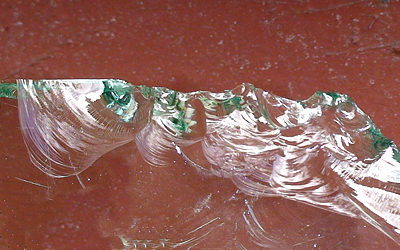When we tested hardness, we were trying to scratch the specimen, not break it. For the next two tests, fracture and cleavage, we will be breaking the specimens. We are not looking at how difficult it is to break them. Instead, we will be looking at how they break, especially at the shape of those broken surfaces. Minerals that break in flat, smooth planes have a property called cleavage, and we will look at those in the next test. Any kind of break that is not cleavage is called fracture, and there are several different kinds.
Safety Warning
Mineral specimens can be just as sharp as broken glass. Be careful, and be safe. Be sure to wear eye protection. This test involves breaking the specimen. Be very careful not to damage delicate or expensive specimens.
Conchoidal fracture

One of the most important fractures is the conchoidal fracture. This is the rounded, shell shaped break that is commonly seen in broken glass. One reason the conchoidal fracture is so useful is that it usually indicates that the mineral does not have cleavage. Without breaking a specimen, you can examine it closely with a magnifying glass. Looking at edges, corners, etc., if you find a place where there is a tiny conchoidal fracture, you can feel fairly sure that the specimen does not have cleavage in any direction, even without breaking the specimen.
Because of their shape, conchoidal fractures are very sharp. A freshly broken flake of glass or quartz can be sharper than a surgical scalpel. That is a very good reason to wear work gloves and eye protection anytime you are breaking rocks or minerals. Those sharp edges were very important to cultures that used stone tools. A knife made of flint can be strong and extremely sharp.
Earthy fracture
An earthy fracture is just what it sounds like. Imagine picking up a clump of dirt and breaking it. Because it is made up of many small bits stuck together, it will break in an irregular pattern. Minerals that are made up of many tiny bits stuck together often break in the same way. Sometimes minerals with cleavage, such as gypsum, will form in very tiny crystals to form masses that break with an earthy fracture.
